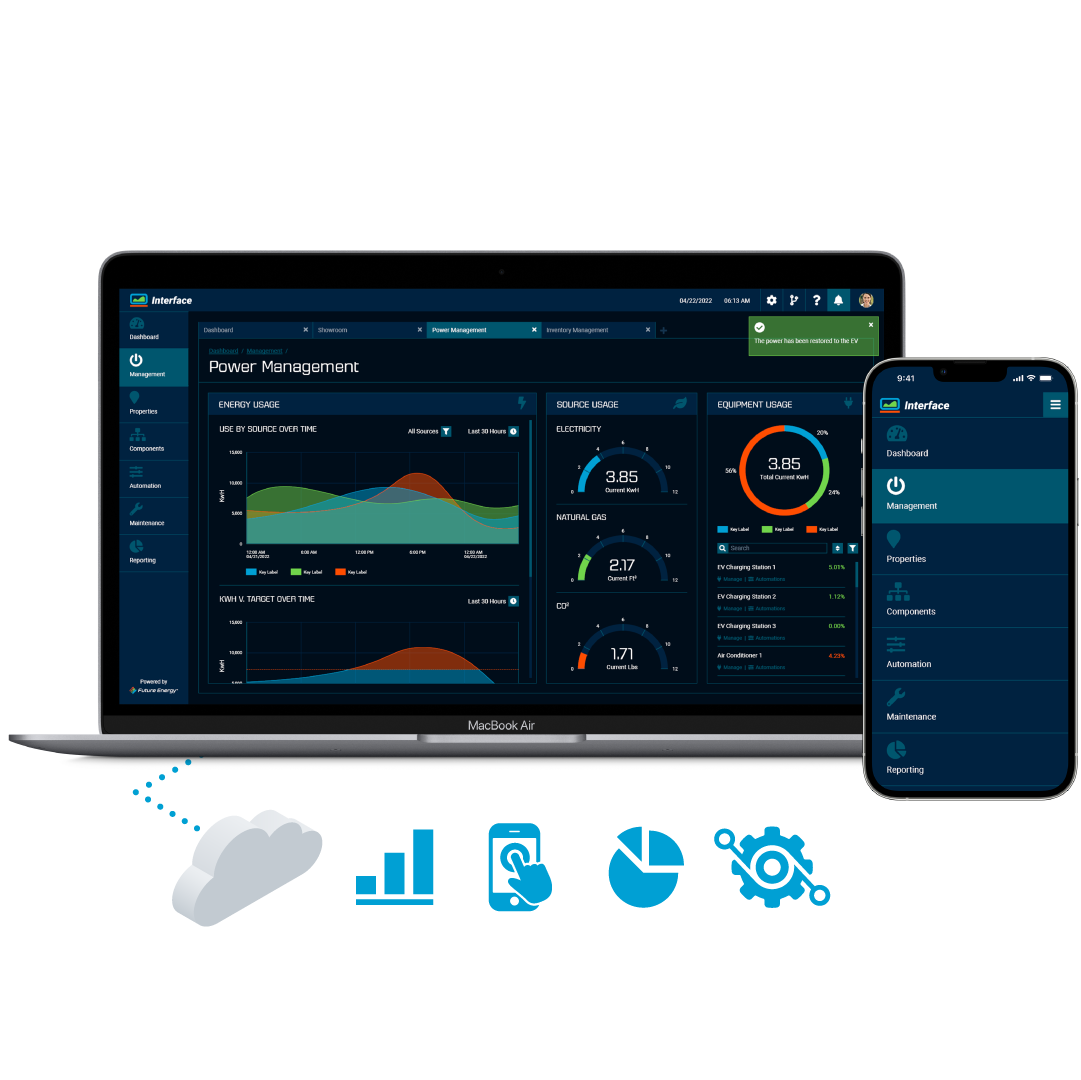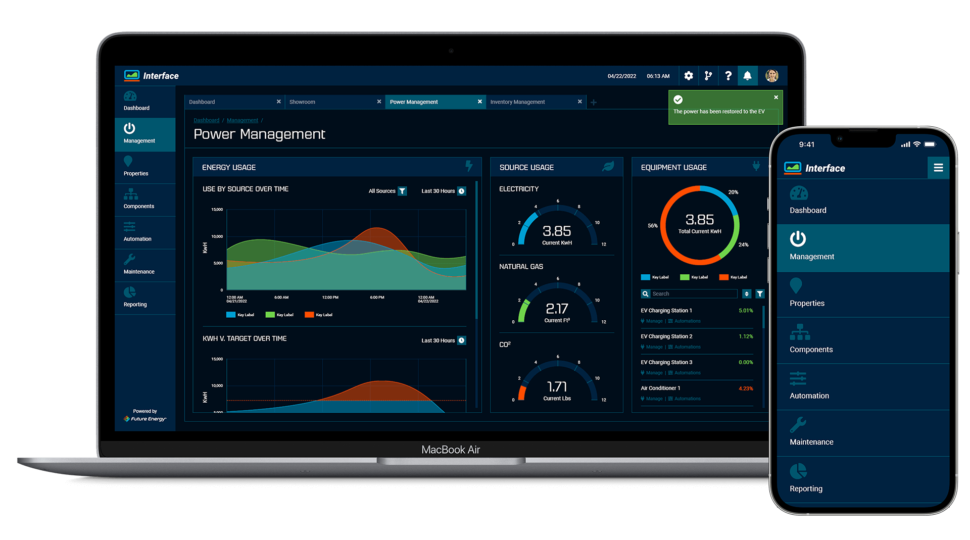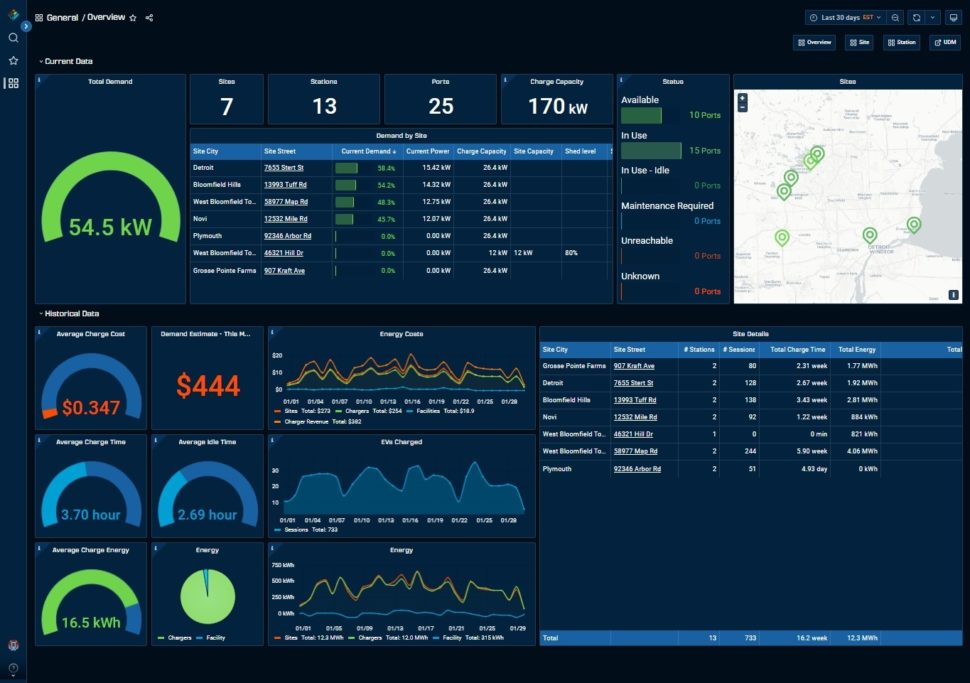Interface 102

As we like to say at Future Energy, you can only manage what you can measure. ChargeParc™ is our complete turnkey environment for electric vehicle (EV) charging, but Future Energy’s solutions go beyond EV charging hardware. Data determines optimal business decision-making.
Future Energy joins cutting-edge technology with each client’s infrastructure through our cloud-based integration and management software, Interface. Interface collects and visualizes data to help improve operations in real time at scale.
For the basics of how Interface works and how EV charging management software can help your company achieve its business objectives, click here for our Interface 101 guide.
Interface uses data in innovative ways to help businesses drive return on investment (ROI) in the near term and into the future.

Using Interface to Optimize Business EV Travel
Fleet managers often deal with optimization challenges in managing their vehicles. Electrified fleets present additional considerations—and opportunities—for fleet managers who understand how to use data from Interface.
Understanding Data from Use Cases
Interface helps companies generate reports and proactively think about business use cases. There are generally three variables to consider:
- When to plug vehicles in
- Which EV chargers to use
- Which EVs should use which chargers
Data helps companies best meet their travel requirements while minimizing operational cost. Interface schedules EV charging to take advantage of discounted time-of-use rates. Businesses can cut EV charging costs by plugging in during off-peak hours, which are generally overnight.
Maximizing Profit in EV Fleet Deployment
In addition to cutting costs, Future Energy helps companies balance EV charging costs and profit opportunities.
For example, Michigan’s DTE Energy offers D1.8 Dynamic Peak Pricing, which provides deep savings to customers who shift their energy usage to lower-price periods. However, there are up to 15 hours a year that DTE considers “critical peak hours” when the price of energy is 100 times more expensive.
But what if the only availability to charge an EV is during a critical peak hour? Data from Interface helps determine if the potential profit from the business operation outweighs the energy cost. In some situations, the amount of profit from a sale may justify the extra energy expenditure.
The savvy use of data allows companies to maximize profits by considering how the revenue generated by a sale offsets operational EV charging costs.
Future Proofing Networked Chargers
Most enterprise EV charging solutions require an upgrade to the business’s electrical infrastructure. Future Energy advocates the installation of level 3 infrastructure, which supports direct-current fast chargers to minimize the need for constant upgrades in the future.
Track Utilization Data
Likewise, Interface helps to futureproof a company’s use of software. We help businesses understand how data drives ROI from EV charging solutions.
Interface helps track the utilization of EV chargers–key to calculating ROI. Future Energy uses available data, such as:
- Federal Highway Administration metrics on average daily traffic
- Interface data about public-facing EV charger use
- EV adoption rates in the community
Balance Supply And Demand For Internal EV Charging Solutions
Interface provides data on supply, such as how frequently a company fully uses its EV charging capacity. You can use Interface to determine exactly when each—and all—of your company’s EV chargers are used.
Perhaps a business has internal data that suggests that EVs have to wait to charge at certain times of the day. That information begins to build a business case for investing in additional EV charging capacity for internal use.
Estimate Roi on Public-Facing Chargers
In the same way, companies can optimize their EV chargers that are available to the public.
Future Energy consultants analyze traffic data and estimate the percentage of EVs that would need to charge as they pass by your business.
In addition, Future Energy uses data analytics to optimize the price point for public EV chargers. Constant use of public-facing EV chargers could be an indication that you’re underpricing the market. Future Energy helps companies boost ROI through the discovery of the market optimum price.
Understanding And Implementing Future Metrics
As detailed in Interface 101, Interface collects and analyzes data from networked EV chargers. This data includes:
- Cost and times of EV charging sessions
- Charging efficiency, such as average station idle time
- Average and maximum power utilization
- Power use of EV chargers compared to that of other building systems

Effect Of Weather on EV Charging
In the future, Interface will be able to account for the effect of weather on EV batteries, which is a factor in EV fleet operation requirements. Cold temperatures affect EV battery range. Interface could help drive recommendations on the best time and day to charge based on a simple weather forecast. For example, a company may factor in off-peak rates and still choose not to charge overnight due to an impending cold front. There are two primary factors that could drive this decision:
- EVs consume less energy when they charge in temperatures above freezing. This may offset the price difference of charging during the day. In other words, an EV’s range decreases in the cold. The same trip requires additional energy in the cold than it would in warmer temperatures.
- The cold increases the viscosity of the EV battery’s electrolyte gel. As a result, the EV charging process might consume an extra 10% to 20% of energy to overcome the viscosity by charging in the cold.
Sustainability Metrics
In support of environmental, social, and governance initiatives, Interface helps provide sustainability metrics. For instance, Interface collects telematic data from every vehicle, such as mileage traveled. Future Energy already has assembled emissions factors for every utility in the United States. Eventually, then, companies will be able to track real-time emissions metrics. Future Energy can provide reports to help companies meet their sustainability goals.

Diagnostic Metrics
Interface can use data to help customers maintain and optimize their EV charging hardware. For example, the software can log data about how often batteries hit their thermal limits, which slows down charging. Interface data will integrate with cutting-edge technologies of the future. For example, Future Energy partner ChargePoint just received a patent for an external EV battery thermal management system. The system pumps external coolant to an internal EV battery to regulate its temperature. Data can reveal how often your EV charging solutions hit thermal limits on EV batteries. When the EV battery approaches its thermal limit, that throttles down charging capabilities. If Interface predicts a thermal limit ahead of time, it can proactively throttle down an EV charger. That way, EV chargers won’t overheat or, at minimum, severely limit the charging speed. The installation of Interface now along with other Future Energy solutions will help with temperature diagnostics when the technology becomes commercially available.
Integrating Interface with Your Property’s Systems
Interface seamlessly integrates across all platforms so that you can monitor and control not only your EV charging but also all intelligent systems, such as lighting and video surveillance. Contact Future Energy today for information on how data from Interface can help optimize your business objectives.
Let’s Connect
Designing smart building connectivity begins with a personal connection. We’ll discuss your goals, budget and timeline, and take it from there.
